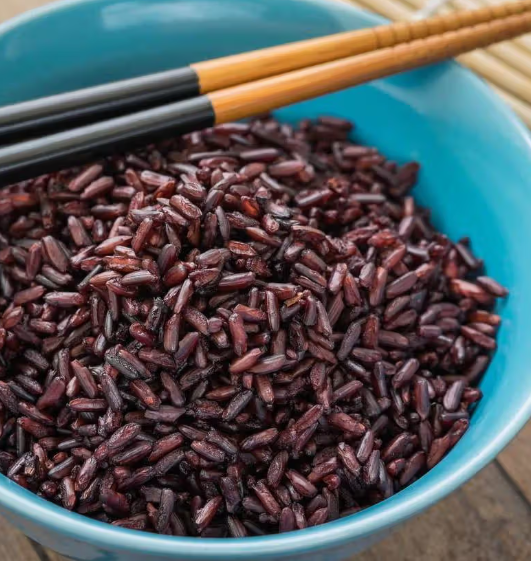
Is Purple Rice a Healthy Choice? Benefits, Drawbacks, and Considerations
Purple rice, also known as black rice or forbidden rice, has garnered attention as a highly nutritious alternative to more common grains like white or brown rice. With its vibrant hue and rich, nutty flavor, this ancient grain is not only eye-catching but also packed with essential nutrients like fiber, antioxidants, and vitamins. Historically reserved for royalty, purple rice is now enjoyed globally for its potential health benefits, including improved digestion, heart health, and anti-inflammatory properties.
But is purple rice as healthy as it seems? In this article, we’ll examine its nutritional profile, health benefits, and any potential drawbacks, helping you decide if it’s the right addition to your diet.
Purple Rice vs. Brown Rice: Which One Is Better for You?
Both purple and brown rice are considered whole grains and offer numerous health benefits, but they differ in their nutrient content, antioxidant levels, and glycemic index. Let’s compare their key attributes to see which one might be the best choice for your diet.
Nutritional Breakdown: Purple Rice vs. Brown Rice
| Nutrient | Purple Rice (100g cooked) | Brown Rice (100g cooked) |
|---|---|---|
| Calories | ~120 kcal | ~110 kcal |
| Carbohydrates | 25g | 23g |
| Fiber | 2g | 1.8g |
| Protein | 3g | 2.5g |
| Antioxidants | High (Anthocyanins) | Moderate (Phenolics) |
| Glycemic Index | ~42-50 (Low) | ~50-55 (Moderate) |
Key Nutritional Differences
Fiber and Digestion
Both purple and brown rice are rich in fiber, which is great for digestive health, weight management, and blood sugar control. Fiber helps prevent constipation, promotes fullness, and can assist with weight loss. Purple rice has a slight edge due to its higher antioxidant content.
Antioxidant Power: Anthocyanins vs. Phenolics
Purple rice stands out because it’s loaded with anthocyanins, the powerful antioxidants found in blueberries, blackberries, and other dark fruits. These antioxidants help reduce inflammation, fight free radicals, and may reduce the risk of heart disease and cancer. Brown rice, though rich in phenolic compounds, offers fewer antioxidants compared to purple rice.
Glycemic Index and Blood Sugar Control
Purple rice has a lower glycemic index (~42-50), meaning it is digested and absorbed more slowly, helping prevent rapid blood sugar spikes. Brown rice has a moderate glycemic index (~50-55), making it a better choice than white rice but not as ideal for blood sugar control as purple rice.
Given its lower glycemic index and higher antioxidant content, purple rice may be particularly beneficial for diabetics or those looking to manage their blood sugar levels.
Purple Rice vs. White Rice: A Nutritional Comparison
| Nutrient | Purple Rice | White Rice |
|---|---|---|
| Calories | 120-130 kcal | 130-140 kcal |
| Fiber | 1.8-2.2g | 0.5-1g |
| Antioxidants | High (Anthocyanins) | None (Processed) |
| Glycemic Index | Low | High |
| Vitamins & Minerals | Magnesium, Iron, Zinc | Low |
Why Purple Rice Is a Healthier Choice
Compared to white rice, purple rice is far more nutrient-dense. It has a higher fiber content, which promotes better digestion, blood sugar control, and weight management. Unlike white rice, which is refined and stripped of many nutrients, purple rice retains its antioxidants, particularly anthocyanins, which combat oxidative stress and reduce the risk of chronic diseases like heart disease and cancer. Furthermore, purple rice has a lower glycemic index, making it a better option for managing blood sugar.
Is Purple Rice Beneficial for Diabetics?
Purple rice is a healthy option for those managing diabetes due to its low glycemic index, high fiber, and antioxidant content.
Glycemic Index and Blood Sugar Control
One of the key benefits of purple rice for diabetics is its low glycemic index (GI), which helps slow the release of glucose into the bloodstream. This slower digestion process prevents sudden blood sugar spikes, making it a better choice for individuals looking to manage their blood sugar.
| Rice Type | Glycemic Index | Fiber Content | Antioxidants |
|---|---|---|---|
| Purple Rice | Low | High | Rich in Anthocyanins |
| Brown Rice | Moderate | High | Low |
| White Rice | High | Low | None |
Fiber Content and Digestion
Purple rice’s higher fiber content slows carbohydrate absorption and helps prevent insulin spikes. This not only keeps blood sugar levels more stable but also supports gut health, which plays a crucial role in metabolic function and insulin sensitivity.
Antioxidants and Diabetes Management
The anthocyanins in purple rice have been shown to reduce inflammation and improve insulin resistance—key factors in managing diabetes. A diet rich in antioxidants can help protect pancreatic cells and improve glucose metabolism, benefiting individuals with type 2 diabetes.
Purple Rice: Calories and Nutrition Facts
Purple rice is not only vibrant but also packed with nutrients. Here’s a detailed look at its nutritional content.
Nutritional Facts (Per 100g Cooked Purple Rice)
-
Calories: 120-130 kcal
-
Carbohydrates: 25-28g
-
Fiber: 1.8-2.2g
-
Protein: 2.5-3g
-
Fat: 0.5g
-
Antioxidants: High (Anthocyanins)
-
Iron: 2-4% DV
-
Magnesium: 5-7% DV
-
Zinc: 3-5% DV
Health Benefits of Purple Rice
-
Rich in Antioxidants: Purple rice is loaded with anthocyanins, antioxidants that help reduce inflammation, combat oxidative stress, and may lower the risk of heart disease and cancer.
-
Supports Heart Health: The fiber, magnesium, and antioxidants in purple rice help reduce LDL cholesterol, lower blood pressure, and promote better circulation.
-
Improves Digestion: The high fiber content supports gut health, improves bowel movements, and promotes a healthy microbiome.
-
Blood Sugar Control: With its low glycemic index, purple rice helps regulate blood sugar levels, making it an ideal choice for those with diabetes or those looking to manage weight.
Possible Side Effects of Purple Rice
While purple rice offers numerous benefits, there are a few considerations to keep in mind:
-
Calorie Content: Purple rice is a calorie-dense food. Overconsumption could lead to excess calorie intake, potentially affecting weight management goals.
-
Arsenic Concerns: Like other rice varieties, purple rice may contain trace amounts of arsenic, a naturally occurring element. It’s advisable to rinse rice thoroughly before cooking and consume it in moderation, particularly for pregnant women and young children.
How to Reduce Arsenic Intake When Cooking Purple Rice
-
Rinse Thoroughly: Rinse rice under cold water to remove surface arsenic.
-
Use Plenty of Water: Cook rice with a higher water-to-rice ratio (about 6 cups of water per 1 cup of rice), and drain excess water after cooking. This method can reduce arsenic content by up to 50%.
-
Rotate Grains: Consider alternating between different grains like quinoa, barley, and millet to reduce overall arsenic exposure.
-
Choose Low-Arsenic Rice: Opt for rice grown in areas with lower arsenic levels, such as California-grown rice.
Conclusion
Purple rice is a highly nutritious grain that offers numerous health benefits, including high antioxidant levels, fiber content, and heart-health support. Compared to white rice, purple rice is a much better choice due to its rich nutrient profile and lower glycemic index. For diabetics and those looking to manage blood sugar, purple rice is an excellent option.
While it’s generally safe to consume in moderation, it’s important to be mindful of its calorie content and arsenic levels. By following proper cooking techniques, purple rice can be a healthy and flavorful addition to your diet. Enjoy it in a variety of dishes to reap its numerous health benefits.




